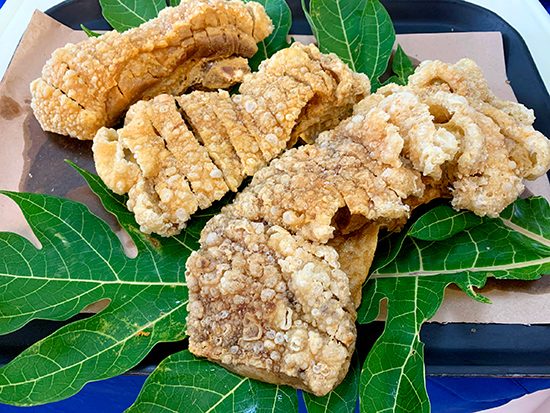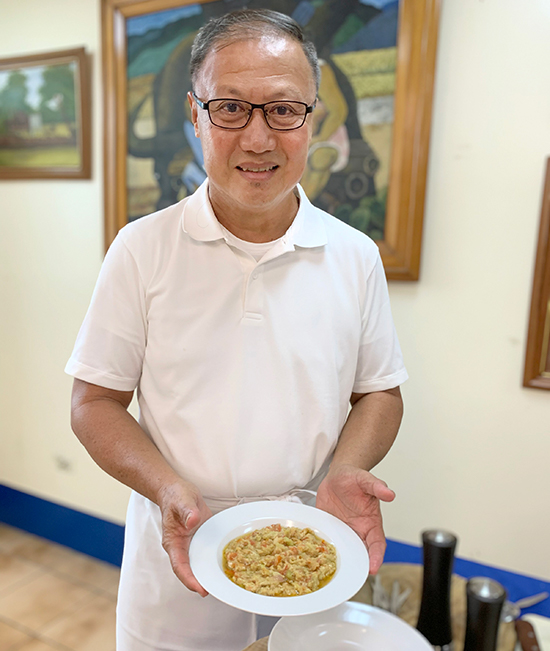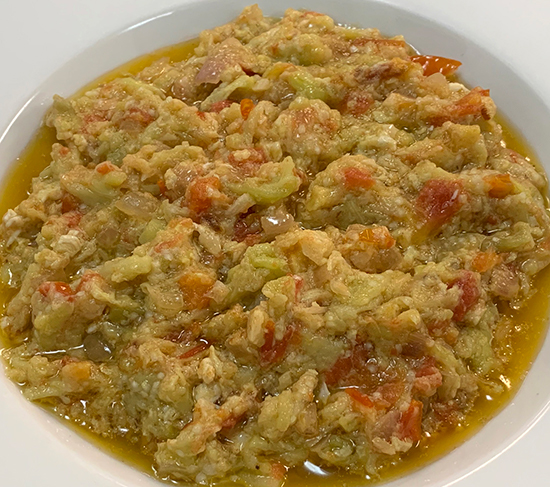The best Ilocano cuisine in Candon
If you happen to be in the Ilocos region, or somewhere up north of the Philippines, be sure to drop by Bistro Candon.
On second thought, even if you’re not in the region, you might still want to consider making a trip to this restaurant, no matter the distance. Located in the city of Candon, Ilocos Sur, this bistro is the kind of eating destination that makes the long drive, and every expensive liter of gasoline expended therein, worth it.
Even the drive in itself is worth undertaking. If you’re coming from Vigan or Ilocos Norte, you’ll be greeted by fresh ocean breezes, a cloudless blue sky, and the relentless pounding of the waves upon the shore as you drive along the winding, well-paved roads. It’s the perfect setting for a restaurant that thrives on the bounties of nature — and a chef’s adherence to what nature has to offer.
Here at Bistro Candon, you’ll find Ilocano food as you’ve never tasted it before: bagnet, poque poque, sinanglao, dinakdakan, pinakbet, as well as non-Ilocano dishes served at their tastiest best: fresh lumpia, sinigang na salmon belly, sizzling pusit and even ultra-thin-crust pizza with Ilocano-inspired toppings.

And then there’s the chocolate cake, which will remind you of the best chocolate cakes you’ve eaten in your childhood. Ilocano food and chocolate cake? That’s only the beginning.
At the helm of this restaurant is chef-owner Peter Nic Rodriguez. Soft-spoken and unassuming, chef Nic studied culinary arts in Les Roches, Switzerland, and honed his skills further at the Culinary Institute of America in Hyde Park, New York. It was a natural choice for a career, he says, considering that as a child, his playground was the kitchen.
“ I would cook bibingka and a lot of desserts. Ginaya ko din yung leche flan ni Mama,” he recalls of his childhood days. Although his college degree was a BA in marketing from San Beda College, he later decided to pursue his passion for cooking with the blessing of his parents. Despite numerous offers later on to work overseas, he decided to return to Candon, where he grew up, to open his own restaurant.
Though based in a small, provincial city, Bistro Candon has reached far and wide. The restaurant caters parties as far north as Ilocos Norte and as far south as Manila.
And what a restaurant it is. Here Rodriguez applies all the techniques he has learned from his overseas training to elevate native cuisine. It’s as if Escoffier himself had come to Candon. To make sinanglaw, for instance, Rodriguez takes the long method of first blanching the oxtail, innards and offal, then boiling them twice before transforming them into the Ilocano soup dish. This removes any lingering funky smell. He also uses only select parts of the innards and offal (he eliminates the kidneys) so that the soup doesn’t become bitter. In effect he has taken the wilderness out of a rustic dish and tamed it to refinement.

Neither would Rodriguez settle for ordinary bagoong. Because he finds commercially made bagoong disappointing, he makes his own fish bagoong. For this he goes to the shore before dawn (he rises at 3 a.m.) to meet the fishermen as they bring in their haul. He even gets on their banca to personally handpick the fish, as a result of which some of the fishermen have become his friends. Whenever they’d have a large catch, they’d already be waving to him even before they reach the shore.
“I don’t like to use fish that has been handled by so many people,” he says, “because then they’re already mushy.” He’s also careful to choose only first-class dilis: ideally they should be finger-size, or at least be the size of a cigarette stick.
To turn the dilis into bagoong, he uses only fine sea salt made in Ilocos. “I don’t like using iodized salt because the chemical gives the bagoong a bitter aftertaste,” he explains.
So refined is the bagoong he makes that he can use it in place of imported anchovies to make the dressing for Caesar salad.
Ever the perfectionist, Rodriguez also cultivates his own rice for the restaurant. For this he did his own research at the International Rice Research Institute. “I’m very choosy when it comes to rice,” he says. After some deliberation, he settled on growing a hybrid variety of rice.
Not content with that, Rodriguez even raises samaral in his own fishpond. Instead of giving the fish commercial feed, he lets them eat a natural diet of lumot (algae) and eggshells, which he pounds finely. This imbues the samaral with a natural sweetness. Thus, when he makes sinigang na samaral, he doesn’t use a souring agent. “We want the customers to taste the natural sweetness of the fish,” he says.
The only drawback is that the samaral is seasonal. During our visit there, the samaral was, unfortunately, out of season. To make up for this, Rodriguez served us oysters — which again, he cultivates himself. “I don’t like buying commercial oysters because of the red tide,” he says, referring to the poisonous menace that sometimes invades the sea. In keeping with his character, he decided to raise his own oysters.
And what marvelous oysters he served us: fat, with just enough heft, they were as fresh as spring rain and had a clean, natural taste.
Though based in a small, provincial city, Bistro Candon has reached far and wide. The restaurant caters parties as far north as Ilocos Norte and as far south as Manila. Often in these catering gigs, the star of the table would be the bagnet. For this Rodriguez uses only choice cuts of pork.
“I use only the liempo or the belly part,” he says, “because it has layers of fat that gives the meat flavor and makes it tender.” Rodriguez emphasizes that he uses only local pork because it’s fresh, unlike imported pork, which usually comes frozen. “You can’t make good bagnet from frozen meat because it will rupture,” he says.
It takes Rodriguez eight hours to cook 20 kilos of bagnet — at the conclusion of which is perfectly tender meat with crunchy, crisp skin very similar to chicharon. Sometimes during parties, a special attraction is the carving of the bagnet; the sound of the cleaver cutting through the crackling pork skin gives guests a preview of the marvelous flavors to come. So exceptionally good is the bagnet that at some weddings, it’s the couple’s giveaway for their guests.
As for the chocolate cake, it was the result of a challenge — and Rodriguez’s own kitchen experiments. Years ago, professor Trinidad Flores gave him a list of ingredients for chocolate cake, but without the measurements.
“Make something out of it — and I’ll see if it will be pasado,” Flores told him.
Working with his gut and instincts, he was able to create a cake that not only passed the professor’s approval, but also tasted so good it has become the standard chocolate cake for his restaurant and catering gigs. Moist, with a chocolate filling and a satiny chocolate frosting, it has a homemade, old-fashioned flavor, with just the right amount of sweetness that comes from the proper blend of cocoa and sugar.
Sometimes Rodriguez muses that his passion for cooking is his way of making up for his lack of book knowledge. Most likely, however, it’s the combination of his passion, his book knowledge (which he certainly doesn’t seem to lack) and his quest for perfection that drives him to create such excellent meals for his customers. An environment surrounded by the beauty of nature also helps.
Poque Poque
Here, chef Peter Nic Rodriguez shares his recipe for poque poque, an eggplant dish said to be brought to Ilocos by Filipino immigrants to Hawaii.

3 eggplants
2-3 tablespoons olive oil or cooking oil
2 teaspoons chopped garlic
2 teaspoons shallots
2 ripe tomatoes, chopped
2 tablespoons patis (or to taste)
Salt (optional)
1 egg, beaten
Grill the eggplants (grilling the eggplants before adding it to the pan gives it an appealing smoky flavor) then peel off the skin. Cut into medium-size pieces. Heat the oil in a cooking pan then add the garlic, shallots and tomatoes. Sauté until wilted. Add the patis (Rodriguez also adds the patis early so that it reduces in volume. This caramelizes the patis and brings out its natural sweetness) and continue sautéing until the tomatoes become mushy and the juice comes out. Lower the heat and keep stirring. Add the grilled eggplants and continue sautéing until the juices of the tomatoes and eggplants evaporate, so the dish doesn’t become watery. Add a little salt if desired.
Stir in the beaten egg and heat just until the egg is cooked through. Serve immediately.


